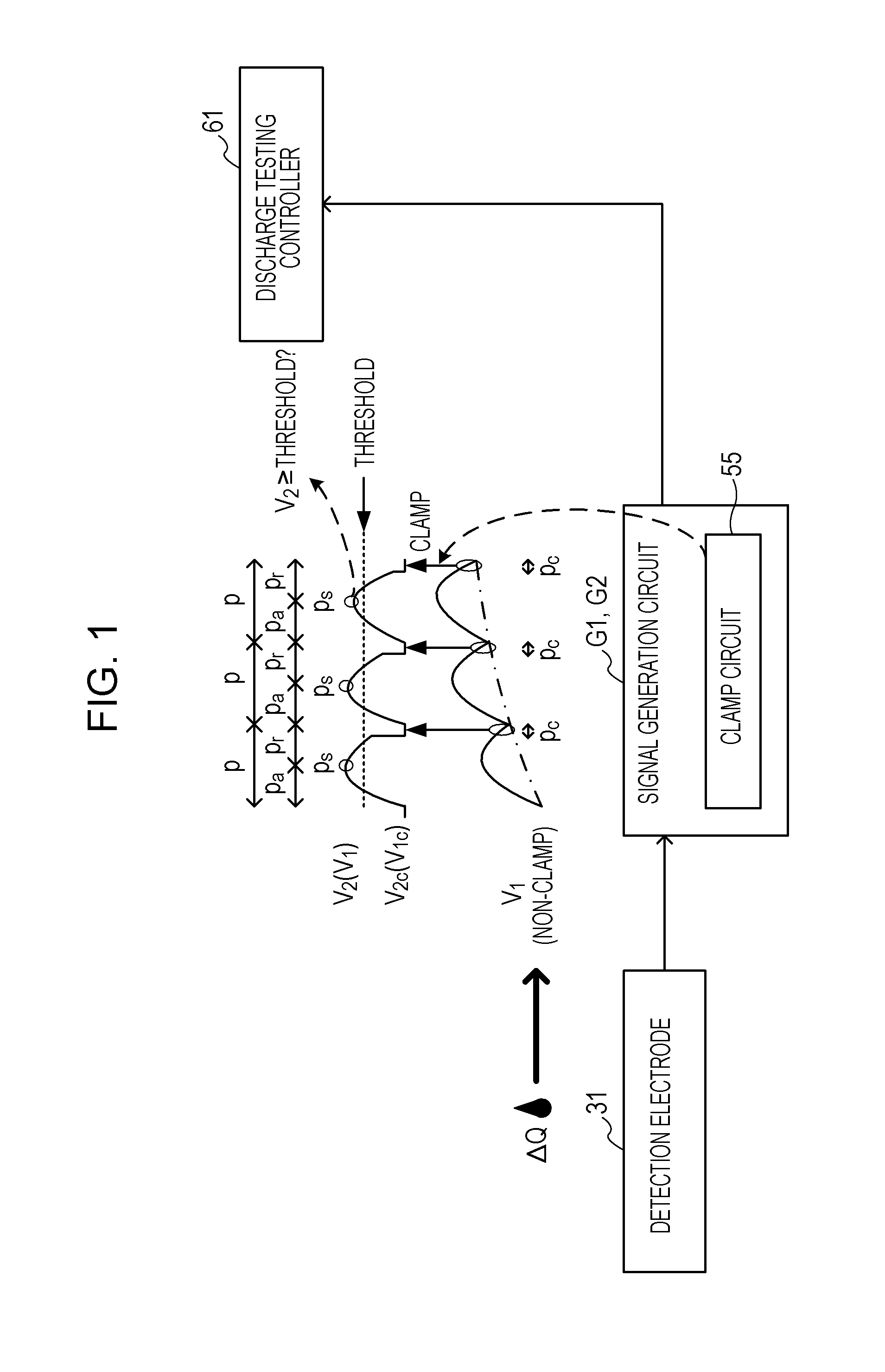[0007]An
advantage of some aspects of the invention is that it provides a discharge testing device determining whether a liquid droplet is discharged normally within a short time.
[0008]According to an aspect of the invention, there is provided a discharge testing device. In the discharge testing device, a discharge controller discharges a liquid droplet from a nozzle such that a discharge testing period including a discharge period in which a liquid droplet is discharged from a nozzle and a non-discharge period in which the liquid droplet is not discharged from the nozzle is repeated. A detection signal acquiring unit acquires a detection signal whose signal strength varies in response to a liquid droplet discharged from a nozzle during the discharge period. A low-pass filter eliminates a
high frequency component from a detection signal, and a first
amplifier amplifies a detection signal and generates a first amplification signal. Further, a restricting unit restricts the signal strength of a first amplification signal to predetermined strength during a restriction period included in the discharge testing period. A second amplifier amplifies a first amplification signal to generate a second amplification signal. A determinator determinates whether a liquid droplet is normally discharged from a nozzle based on the signal strength of a second amplification signal during a sampling period after a predetermined time elapses from the restriction period.
[0009]Since the restriction period is included in the discharge testing period, the signal strength of a first amplification signal having a period equal to or shorter than the discharge testing period is restricted to predetermined strength. In so doing, a
noise component in the signal strength is prevented from being accumulated through a plurality of discharge testing periods. Accordingly, influence of a
low frequency noise component superimposed on the first amplification signal may be suppressed. Further, it may be compared with a case of suppressing a
low frequency noise component using a high-pass filter to prevent
waveform distortion and
delay of the detection signal, and the time period required to the discharge of a liquid droplet from a nozzle to the performance of the determination process by the determinator may be reduced. Accordingly, by repeating a large number of discharge testing periods, the time period required for performing discharge testing for a plurality of nozzles may be reduced. On the other hand, because a low-pass filter eliminates a
high frequency component from a detection signal, it may suppress the influence of a high
frequency noise component superimposed on the first amplification signal. Accordingly, a determination result having high noise resistance may be obtained. Furthermore, since a second amplifier is provided in addition to the first amplifier, although the amplification rate in the first amplifier is suppressed, it may be supplemented by the second amplifier. Accordingly, this may prevent the first amplification signal from exceeding an output possible range of the first amplifier,
distortion of a
signal wave due to clipping may be prevented, and deterioration of determination precision due to
distortion of the signal wave may be prevented.
[0011]In addition, a secondary restricting unit restricting signal strength of a first amplification signal during a secondary restriction period after a sampling time instead thereof during a discharge testing period may be included. Moreover, the determinator may determine whether a liquid droplet is normally discharged in consideration of signal strength of the second amplification signal in a secondary sampling time after a predetermined time elapses from the secondary restriction period. That is, during a single discharge testing period, two sets of convergence and sampling are provided, so that determination may be made in consideration of signal strength of a second amplification signal in two sampling times, and reliance of the determination may be improved. Because restriction is performed to reduce the influence of
low frequency noise with suppression of
delay in the detection signal, although a set of restriction and sampling is provided twice, the time required for discharge testing being lengthened may be prevented.
[0012]A restricting unit restricts signal strength of a first amplification signal with predetermined strength, but a switch switching to the predetermined strength in a plurality of strengths may be provided. Here, the signal strength of the first amplification signal is restricted to a predetermined strength and is changed based on a predetermined strength. Accordingly, the restricting unit switches a predetermined strength restricting signal strength of the first amplification signal, and a strength band whose signal strength of the first amplification signal varies may be adjusted. That is, when noise is included in a signal strength of the first amplification signal, the strength signal is switched such that a signal strength of the first amplification signal may be changed to the strength band in which the signal strength of the first amplification signal have no problems. For example, signal strength of the first amplification signal does not exceed an output allowable range, and
waveform distortion may be prevented due to clamp of the first amplification signal.
[0013]Further, the discharge testing device may further includes a plurality of signal generators that include a detection signal acquiring unit, a low-pass filter, a first amplifier, a restricting unit, and a second amplifier, and the detection signal acquiring units may acquire a detection signal whose signal strength varies in response to liquid droplets discharged from different nozzles, respectively. In doing so, discharge testing for different nozzles may be performed in a parallel way, and the period required to perform discharge testing for a plurality of nozzles may be reduced.
 Login to View More
Login to View More  Login to View More
Login to View More 


